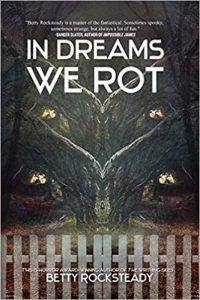In Dreams We Rot
Betty Rocksteady
October 2019
Trepidatio Publishing
Reviewed by Gordon B. White
Betty Rocksteady’s debut collection, In Dreams We Rot (Trepidatio Publishing, 2019), brings together twenty stories that smear the boundaries between horror, Weird, and surreal fiction. Circling the themes of alienation and loss, the dark spirals and squalls of speculative static part to reveal deep wounds of the heart and soul. Her fiction is disorienting and dreamlike in the best and most terrifying senses of the words, refusing to offer easy answers or escape. As the title implies, “Even in dreams, we rot,” but, oh, how that rot makes such darkly alluring patterns.
The seventeen reprints and three original stories collected here run the gamut of horror, Weird, extreme, bizarro, transgressive, and unflinchingly surreal fiction. They also range in length from brief vignettes—bracing flashes of lightning that provide momentary illumination and a terrible shock—to more traditionally shaped stories, all flowing along like a river of nightmares. This is a collection that readers can enter from any point, toeing in at the shallows on the bank or plunging into the depths, but they’re always guaranteed to find something fascinatingly strange just beneath the surface.
Rocksteady writes without shame or embarrassment. She declines to obscure the world of the body and the realm of the heart in abstraction or euphemism. Here, longing and loss are stripped bare—sometimes literally. For example, “Lonely Hearts Club” starts with the sentence “On our fifth date, I ripped his heart out,” and only escalates from there to become a gory, gruesome, and—yes—gorgeous metaphor for being in a relationship. In “The Language of Mud,” by comparison, the horror is no less grounded, although it digs into the banality of an otherwise unremarkable patch of dirt. Even pieces that deal in allegory, such as the surreal exploration of outgrowing a relationship in “This Narrow Escape,” are never indecisive. What Rocksteady is aiming for is always clear and captivating.
To that end, what Rocksteady’s writing offers is a marvel of construction. While the atmospheres she crafts can be dreamlike and the scenarios she concocts are nightmarish, they are never vague or nebulous. She understands how to raise up a believably mundane world as a scaffold before dropping the curtain to reveal the madness beneath. She understands that what makes the nighttime logic and hypnagogic states work is the way that sharp, specific details lodge like splinters in the folds of our attention—the mounting oddness of “Tiny Bones Beneath Their Feet,” or the titular oddities of “Elephants That Aren’t.” As a result, Rocksteady’s writing rarely feels unmoored, unless that’s the effect she intends to invoke, such as the roaring road-trip fugue of “The Desert of Wounded Frequencies” or the experimental (dis)assemblage of 55 55-word stories in “The Taste of Sand on Your Lips.” Her dreamscapes might be strange and alien, but the clarity with which she presents them makes them believable…even if only by their own rules.
While there are certain recurring pet themes and motifs—cats recur as sources of mystery and cosmic menace; dark forests loom without (and sometimes within); bursts of static puncture the dreams like a blaring outside alarm—the thematic thread that unites the stories here is a sense of inevitable degradation. It’s no surprise that in a horror collection life and limb are routinely threatened, but here—as the title tells us—dreams are no escape. Connections, relationships, sex, love, solitude, art, dreams…all of these are attempts at escape not from senselessness, but from the undeniable eventual decay of idealism. In “Postpartum,” for example, our protagonist tries to cobble together a new life from the remnants of loss, but just because she tries doesn’t mean she’ll succeed. The search for closure in “Love is Not a Handful of Seeds” or “The Language of Mud” offers precious little more than the titles suggest. Even the moments of beauty—such as the eerie beauty in “The Botany of Desire,” “Larva, Pupa, Moth,” or “Crimson Tide”—are not untouched by the lingering uncanniness and horror. The beautiful dreams fall apart, while the bad ones continue on in deterioration. It’s dark stuff, to be sure.
None of that, however, is to say that these stories are unrelenting or will grind down the reader. Instead, the author’s ability to draw out strange new twists on existing tropes and craft gripping stories in a wide variety of modes gives each piece its own allure—each examination of the decay and corruption is beautiful in its own twisted, yet inescapable way. Because each piece elaborates on different aspects and different forms of dark fiction, each reader will find their own favorites here. For this reader, those include the mounting dread of “Something is Coming,” the deterioration and reconstruction of grief in “Postpartum,” the alienation of the home in “Lullabies from the Formicary,” and the choppy experimentalism of “The Taste of Sand on Your Lips.” Everyone who tunes in, however, will come across their own resonances and strange frequencies.
Betty Rocksteady’s In Dreams We Rot is a collection of immaculately recorded nightmares. Displaying an impressive range across the borders of horror and Weird fiction, each story executed by a consummate crafter, every reader will find something dark and delicious to their own specific tastes. While the stories here offer no hope of escape, they’re wonderful places to linger and enjoy the rot for a while.









